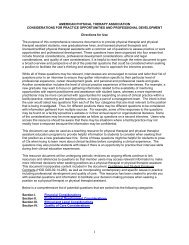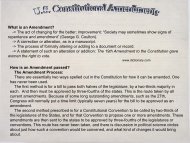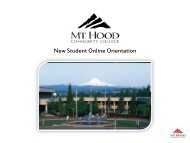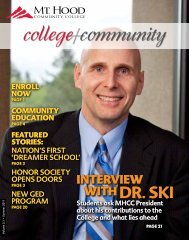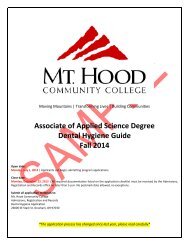PROFESSIONALISM IN PHYSICAL THERAPY: CORE VALUES ...
PROFESSIONALISM IN PHYSICAL THERAPY: CORE VALUES ...
PROFESSIONALISM IN PHYSICAL THERAPY: CORE VALUES ...
- No tags were found...
You also want an ePaper? Increase the reach of your titles
YUMPU automatically turns print PDFs into web optimized ePapers that Google loves.
<strong>PROFESSIONALISM</strong> <strong>IN</strong> <strong>PHYSICAL</strong> <strong>THERAPY</strong>: <strong>CORE</strong> <strong>VALUES</strong> BOD P05-04-02-03Core Values Definition Sample IndicatorsAccountability Accountability is active 1. Responding to patient’s/client’sacceptance of the goals and needs.responsibility for thediverse roles, obligations, 2. Seeking and responding to feedbackand actions of the physicaltherapist including selfregulationand otherbehaviors that positivelyinfluence patient/clientoutcomes, the professionand the health needs ofsociety.from multiple sources.3. Acknowledging and acceptingconsequences of his/her actions.4. Assuming responsibility forlearning and change.5. Adhering to code of ethics,standards of practice, andpolicies/procedures that govern theconduct of professional activities.6. Communicating accurately to others(payers, patients/clients, other health careproviders) about professional actions.7. Participating in the achievement ofhealth goals of patients/clients andsociety.8. Seeking continuous improvement inquality of care.9. Maintaining membership in APTAand other organizations.10. Educating students in a manner thatfacilitates the pursuit of learning.
DefinitionSample IndicatorsCore ValuesAltruismCompassion/CaringAltruism is the primaryregard for or devotion tothe interest ofpatients/clients, thusassuming the fiduciaryresponsibility of placingthe needs of thepatient/client ahead of thephysical therapist’s selfinterest.Compassion is the desireto identify with or sensesomething of another’sexperience; a precursor ofcaring.1. Placing patient’s/client’s needsabove the physical therapists.2. Providing pro-bono services.3. Providing physical therapy servicesto underserved and underrepresentedpopulations.4. Providing patient/client servicesthat go beyond expected standards ofpractice.5. Completing patient/client care andprofessional responsibility prior topersonal needs.1. Understanding the socio-cultural,economic, and psychological influenceson the individual’s life in theirenvironment.2. Understanding an individual’sperspective.Caring is the concern,empathy, andconsideration for the needsand values of others.3. Being an advocate forpatient’s/client’s needs.4. Communicating effectively, bothverbally and non-verbally, with otherstaking into consideration individualdifferences in learning styles, language,and cognitive abilities, etc.5. Designing patient/client programs/interventions that are congruent withpatient/client needs.6. Empowering patients/clients toachieve the highest level of functionpossible and to exercise selfdeterminationin their care.
7. Focusing on achieving the greatestwell-being and the highest potential for apatient/client.8. Recognizing and refraining fromacting on one’s social, cultural, gender,and sexual biases.9. Embracing the patient’s/client’semotional and psychological aspects ofcare.10. Attending to the patient’s/client’spersonal needs and comforts.11. Demonstrating respect for others andconsiders others as unique and of value.DefinitionSample IndicatorsCore ValuesExcellenceExcellence is physicaltherapy practice thatconsistently uses currentknowledge and theorywhile understandingpersonal limits, integratesjudgment and thepatient/client perspective,embraces advancement,challenges mediocrity, andworks towarddevelopment of newknowledge.1. Demonstrating investment in theprofession of physical therapy.2. Internalizing the importance ofusing multiple sources of evidence tosupport professional practice anddecisions.3. Participating in integrative andcollaborative practice to promote highquality health and educational outcomes.4. Conveying intellectual humility in
IntegrityIntegrity is steadfastadherence to high ethicalprinciples or professionalstandards; truthfulness,fairness, doing what yousay you will do, and“speaking forthâ€about why you do whatyou do.professional and interpersonal situations.5. Demonstrating high levels ofknowledge and skill in all aspects of theprofession.6. Using evidence consistently tosupport professional decisions.7. Demonstrating a tolerance forambiguity.8. Pursuing new evidence to expandknowledge.9. Engaging in acquisition of newknowledge throughout one’s professionalcareer.10. Sharing one’s knowledge withothers.11. Contributing to the development andshaping of excellence in all professionalroles.1. Abiding by the rules, regulations,and laws applicable to the profession.2. Adhering to the highest standards ofthe profession (practice, ethics,reimbursement, Institutional ReviewBoard [IRB], honor code, etc).3. Articulating and internalizing statedideals and professional values.4. Using power (including avoidanceof use of unearned privilege) judiciously.5. Resolving dilemmas with respect toa consistent set of core values.6. Being trustworthy.7. Taking responsibility to be anintegral part in the continuing
management of patients/clients.8. Knowing one’s limitations andacting accordingly.DefinitionSample IndicatorsCore ValuesIntegrity(Continued)9. Confronting harassment and biasamong ourselves and others.10. Recognizing the limits of one’sexpertise and making referralsappropriately.11. Choosing employment situationsthat are congruent with practice valuesand professional ethical standards.Professional DutyProfessional duty is thecommitment to meetingone’s obligations toprovide effective physicaltherapy services topatients/clients, to servethe profession, and topositively influence thehealth of society.12. Acting on the basis of professionalvalues even when the results of thebehavior may place oneself at risk.1. Demonstrating beneficence byproviding “optimal careâ€.2. Facilitating each individual’sachievement of goals for function, health,and wellness.3. Preserving the safety, security andconfidentiality of individuals in allprofessional contexts.4. Involved in professional activitiesbeyond the practice setting.5. Promoting the profession ofphysical therapy.6. Mentoring others to realize their
potential.Social ResponsibilitySocial responsibility is thepromotion of a mutualtrust between theprofession and the largerpublic that necessitatesresponding to societalneeds for health andwellness.7. Taking pride in one’s profession.1. Advocating for the health andwellness needs of society includingaccess to health care and physical therapyservices.2. Promoting cultural competencewithin the profession and the largerpublic.3. Promoting social policy that effectfunction, health, and wellness needs ofpatients/clients.4. Ensuring that existing social policyis in the best interest of the patient/client.5. Advocating for changes in laws,regulations, standards, and guidelines thataffect physical therapist serviceprovision.6. Promoting communityvolunteerism.7. Participating in political activism.8. Participating in achievement ofsocietal health goals.DefinitionSample IndicatorsCore ValuesSocial Responsibility(Continued)9. Understanding of currentcommunity wide, nationwide andworldwide issues and how they impactsociety’s health and well-being and thedelivery of physical therapy.
10. Providing leadership in thecommunity.11. Participating in collaborativerelationships with other healthpractitioners and the public at large.12. Ensuring the blending of socialjustice and economic efficiency ofservices.References1. Albanese, M. Students are not customers: A better model for education.Acad Med. 1999; 74(11):1172-1186.2. American Physical Therapy Association. A Normative Model of PhysicalTherapist Professional Education: Version 2000. American PhysicalTherapy Association, Alexandria, VA; 2000.3. Arnold, L. Assessing professional behavior: Yesterday, today and tomorrow.Acad Med. 2002; 77(6):4. Cary, JR, Ness, KK. Erosion of professional behaviors in physical therapiststudents. Journal of Physical Therapy Education. 2001; 15 (3):20-24.5. Cohen, CB, Wheeler, SE, Scott, DA and the Anglican Working Group inBioethics. Walking a fine line: Physician inquiries into patient’s religious andspiritual beliefs. HastingsCenterReport 31. 2001; 5:29-39.6. Coles, R. The moral education of medical students. Acad Med. 1998; 73(1):55-57.7. Covey, SR. The Seven Habits of Highly Effective People: Powerful Lessonsin Personal Change. Simon & Schuster Adult Publishing Group, New York,NY: August 1990.8. Covey, SR, Merrill RA, Merrill RR. First Things First: To Live, To Love, ToLearn, To Leave a Legacy. Simon & Schuster Trade Paperbacks, NewYork, NY: May 1995.9. Covey, SR, Reynolds. Principled-Centered Leadership: Strategies forPersonal and Professional Effectiveness. Simon & Schuster AdultPublishing Group, New York, NY: September 1992.10. DeRosa, C. Innovation in physical therapy practice. PT Magazine. February2000:40-46.11. Epstein, RM. Mindful practice. JAMA. 1999; 282(9):833-839.12. Fox, RC. Time to heal medical education? Acad Med. 1999; 74(10):1072-1075.13. Ginsburg, S, Regehr, G, Stern, D, Lingard, L. The anatomy of the professionallapse: Bridging the gap between traditional frameworks and students’ perceptions.Acad Med. 2002; 77(6):
14. Greenlick, MR. Educating physicians for the twenty-first century. Acad Med.1995; 70(3):179-185.15. Hayward, LM, Noonan, AC, Shain, D. Qualitative case study of physical therapiststudents’ attitudes, motivations, and affective behaviors. J Allied Health. 1999;28: 155-164.16. Hensel, WA, Dickey, NW. Teaching professionalism: Passing the torch. AcadMed. 1998; 73(8):865-870.17. Kirschenbaum H. Values clarification to character education: A personal journey.Journal of Humanistic Counseling, Education, and Development. 2000;39(1):4.18. Kopelman, LM. Values and virtues: How should they be taught? Acad Med.1999; 74(12):1307-1310.19. Ludmerer, KM. Instilling professionalism in medical education. JAMA. 1999;282(9):881-882.20. MacDonald, CA, Cox, PD, Bartlett, DJ, Houghton, PE. Consensus on methods tofoster physical therapy professional behaviors. Journal of Physical TherapyEducation. 2002; 16(1):27-35.21. Markakis, KM, Beckman, HB, Suchman, AL, Frankel, RM. The path toprofessionalism: Cultivating humanistic values and attitudes in residency training.Acad Med. 2000; 75(2): 141-150.22. May WW, Morgan BJ, Lemke JC, Karst GM, et al. Development of a model forability-based assessment in physical therapy education: One program’sexperience. Journal of Physical Therapy Education, 1995, 9 (1):3-6.23. Pellegrino, ED. Toward a virtue-based normative ethics for the health professions.Kennedy Institute of Ethics Journal. 1995:5(3): 253-277.24. Perry, J. Professionalism in physical therapy. Phys Ther. 1964; 44(6):429-434.25. Robins, LS, Braddock III, CH, Fryer-Edwards, KA. Using the American board ofinternal medicine’s “elements of professionalism†for undergraduate ethicseducation. Acad Med. 2002; 77(6):26. Sullivan, WM. What is left of professionalism after managed care?HastingsCenterReport 29. 1999; 2:7-13.27. Swick, HM. Szenas, P, Danoff, D, Whitcomb, ME. Teaching professionalism inundergraduate medical education. JAMA. 1999; 282(9):830-832.28. Triezenberg, HL. Teaching ethics in physical therapy education: A Delphi study.Journal of Physical Therapy Education. 1997; 11(2):16-22.29. Triezenberg, HL, McGrath, JH. The use of narrative in an applied ethics coursefor physical therapist students. Journal of Physical Therapy Education. 2001;15(3): 49-56.30. Weidman, JC, Twale, DJ, Elizabeth LS. Socialization of Graduate andProfessional Students in Higher Education: A Perilous Passage? ASHE-ERIC Higher Education Report Volume 28, Number 3. San Francisco, CA:Jossey-Bass; 2001.Relationship to Vision 2020: Professionalism



